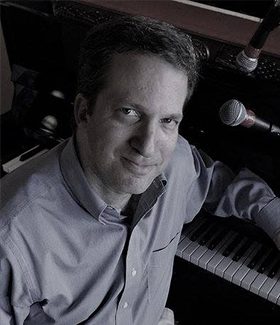Renewed Fascination With Royals Deepens Tradition of Tragedy
Saturday In The Arts is a weekly look at a personality, place, trend or topic of interest to the Quad-Cities. It runs every Saturday morning on your site for fun, free, local entertainment and features, QuadCities.com.

Wealth and power don’t guarantee happiness. We’ve seen that over and over throughout history – from Greek tragedy to Shakespearean rulers, through the many curses and deaths of the Kennedy family (the closest America has to a royal family).
The new fourth season of “The Crown” – the stunning, sumptuous dramatic series on Netflix – leans heavily into foreboding, dread, and clashes that tear into the heart of a nation, royal tradition, family, and one of the most closely scrutinized marriages of all time.
The excellent, emotionally revealing rendering pulls back the curtain on legendary British figures most of us have only read about, and the current season covers events people like me were around for, in the 1980s.
“The Crown” portrays the life of Queen Elizabeth II (who’s now 94) from her wedding in 1947 to Philip, Duke of Edinburgh, until the early 21st century. Claire Foy portrays Elizabeth in seasons one and two, and Olivia Colman in seasons three and four. Foy returned for a brief cameo in a flashback scene in the fourth season (when she was 21 in South Africa). Imelda Staunton will portray the Queen in the fifth and sixth seasons, starting in 2022.
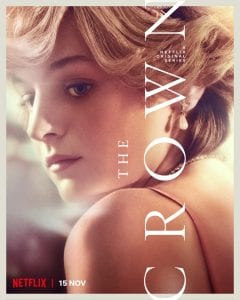
Season 4 of “The Crown” stars Emma Corrin as Diana, Princess of Wales.
The first season depicts events up to 1955, with Winston Churchill resigning as prime minister and the Queen’s sister Princess Margaret deciding not to marry Peter Townsend. The second season covers the Suez Crisis in 1956, leading to the retirement of Prime Minister Anthony Eden; the retirement of Prime Minister Harold Macmillan in 1963, following the scandal of the Profumo affair; and the birth of Prince Edward in 1964.
The third season covers 1964 to 1977, beginning with Harold Wilson‘s election as prime minister and ending with her Silver Jubilee, also covering Edward Heath‘s time as prime minister.
The fourth season is set during Margaret Thatcher’s period as prime minister and also focusses on Diana, Princess of Wales. Events depicted include Lord Mountbatten‘s funeral, the wedding of Prince Charles and Lady Diana (however only fleetingly), the births of Princes William and Harry, the Falklands War, Michael Fagan‘s break-in at Buckingham Palace, the Prince and Princess of Wales’s 1983 tour of Australia and New Zealand and Thatcher’s departure from office.
What’s most fascinating is witnessing the bitter rivalries among siblings, the tense relationships between generations, and the intense weight of some of the already portentous story, knowing what further horrors await key characters later on beyond this season (such as divorces, Diana’s death and Prince Andrew’s link to Jeffrey Epstein).
Elizabeth II is the longest-reigning monarch in U.K. history (and fourth longest royal ever in the world), the granddaughter of King George V. When her grandfather died in 1936 and her uncle succeeded as Edward VIII, she became second in line to the throne, after her father.
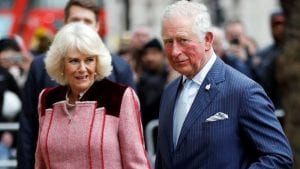
Prince Charles and Camilla Parker Bowles married in 2005.
Foreshadowing other royal divorces, later that year, Edward abdicated, after his proposed marriage to divorced socialite Wallis Simpson provoked a constitutional crisis. Consequently, Elizabeth’s father became king, and she became heir presumptive.
She married Prince Philip (who’s now 99!) in 1947, and became queen in 1952, following the death of Elizabeth’s father, King George VI. On “The Crown,” Princess Margaret has been a consistently tragic character, as she lives in the queen’s shadow, is much more lively and rebellious in personality, but is denied a fairy-tale ending.
Like Edward VIII, Margaret wanted to marry someone who was divorced — Peter Townsend, 16 years Margaret’s senior, with two sons from his previous marriage. Senior politicians were against the match and the Church of England did not permit remarriage after divorce.
If Margaret had contracted a civil marriage, she would have been expected to renounce her right of succession, so she abandoned her plans with Townsend. In 1960, she married Antony Armstrong-Jones, who was created Earl of Snowdon the following year. They divorced in 1978; she did not remarry. Vanessa Kirby and Helena Bonham Carter are both outstanding as the cynical, snarky Margaret.
The current season of the series starts around the same time, introducing us to the two dominating figures that transfixed Britain and the
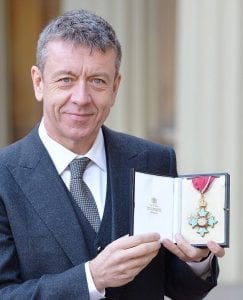
Peter Morgan wrote “The Queen,” and is the creator/writer of “The Crown.”
world in the ‘80s – Diana Spencer and Margaret Thatcher, both tragic in their own ways.
Thatcher (1926-2013) was just six months older than Queen Elizabeth, and is played with chilling, brisk, unfeeling authority by Gillian Anderson. While the queen is often thought of as a cold, distant figure – as sympathetically embodied by Olivia Colman, Elizabeth is a plush, warm blanket in comparison with this Margaret – the first female prime minister in England’s history.
“The Crown” shows us their disagreements (though the queen is historically to remain publicly impartial) in some of their weekly visits at Buckingham Palace.
In the episode beginning with Claire Foy giving the queen’s 1947 radio address from Cape Town, the queen years later was frustrated with Mrs. Thatcher when she refused to join the 48 other members of the British Commonwealth (at the time) in backing sanctions against the apartheid regime in South Africa.
This highly unusual clash spilled into public when The Sunday Times published its front-page report, attributed to palace officials, which said the royal family viewed Thatcher as “uncaring, confrontational and socially divisive.”
The prime minister didn’t feel sanctions would be effective and would disrupt trade between the countries. There’s a fairly ridiculous back and forth between Thatcher and the palace when each draft was crossed out by Thatcher until she agreed to finally label the commonwealth’s moves as “signals,” not sanctions.
The far reach of the British Empire is reflected in the episode about the remote Falkland Islands – 8,000 miles from England, in the South Atlantic, 300 miles off the coast of Argentina. Chief question: why did Britain rule the islands anyway?
Argentina had claimed sovereignty over the Falkland Islands, since the early 19th century, but Britain seized the islands in 1833, expelling the few remaining Argentine occupants, and since then consistently rejected Argentina’s claims. In early 1982 the Argentine military junta led by Lieut. Gen. Leopoldo Galtieri gave up on long-running negotiations with Britain and instead launched an invasion of the islands. Thatcher would have none of it, and over a two-month war, seized control over the Falklands again.
In “The Crown,” a husky-voiced Anderson imbues the leader with that determined ruthlessness, which favored spending exorbitant sums on military conflict, while caring not a whit about the suffering of her own citizens.
Diana as doll-like, naïve victim
Divorce and adultery drape the central focus of this season’s “The Crown” like a royal robe, as the geeky, self-hating Prince Charles is cast as the villain and the nearly saintly teenage Diana as the doomed victim. Ably played by Josh O’Connor and Emma Corrin, viewers can quickly relate to each of their fates – which were, in reality, more complex than presented here.
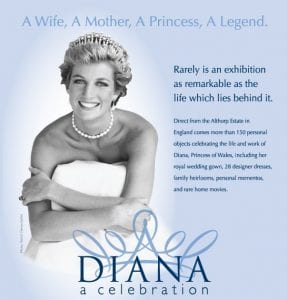
“Diana: A Celebration” was at the Putnam from September 2013 to January 2014.
Charles (32 years old in 1981) is clearly in love with the married Camilla Parker Bowles, but for some reason, we NEVER see her husband, Andrew (whom she married in 1973). One imagines what if Charles and Camilla had married first? Andrew previously had dated Charles’ sister, Anne. So much heartbreak could have been avoided.
Diana – the youngest daughter of John Spencer, 8th Earl Spencer, and Frances Shand Kydd — was strongly affected by her parents’ own divorce in 1967. One of the many things “The Crown” enlightened me on was that Diana was talented in music and dance, which led to a late-season high drama at a Royal Opera House performance.
Married to Prince Charles at 20, the royal wedding on July 29, 1981 (seen by 750 million people worldwide) is only glancingly depicted in the series, where we briefly see Corrin wearing her gown beforehand. Peter Morgan, “The Crown” creator and writer, has said they didn’t reenact the gilded, gargantuan wedding ceremony since anyone literally can watch it on YouTube.
We do see the famous engagement interview Charles and Diana did six months earlier. The TV reporter asked, “Are you in love?” and Diana years later replied in a different interview, “I thought, what a thick question. So I said, ‘Yes, of course, we are,’ and Charles turned round and said, ‘Whatever love means.’ And that threw me completely. I thought, what a strange answer. It traumatized me.”
That, of course, was not a good sign for the marriage, which foundered despite the birth of their two sons – who went on to have two of the most stable marriages imaginable. Charles doesn’t give up on his devotion to Camilla, on whom he depends as a best friend and counselor.

The Princess Diana exhibit featured her tiara.
Complete with trigger warnings at the outset of certain episodes, we painfully watch Diana vomit through bouts of bulimia, completely at sea and miserable in this awkward, loveless union. While we don’t witness it to nearly the same degree, Diana had her own affairs during the marriage, and Colman as the queen unsuccessfully tries to repair the breach.
One of many highlights in the series is (in episode 9) the late 1985 performance at the Royal Opera House (for Charles’ birthday), in which Diana surprised her husband by going on stage to dance to Billy Joel’s “Uptown Girl” with the diminutive Wayne Sleep.
She’s obviously having fun, wanting to show off, and the audience goes wild, but a jealous Prince Charles was embarrassed and monstrously berates her on the ride home, thundering his disgust and disappointment. It’s brutal to watch, and a wonder Diana didn’t seek a divorce then and there.
“When Diana walked on after I did my turns and jumps, she strode in like a tigress,” Sleep recalled in a recent interview with Town & Country. “We only did one rehearsal that day on a closed set…She couldn’t have danced it better. I was the nervous one! I was shaking in the wings. What if she doesn’t like it? What if I dropped the future Queen of England?”
As for the audience’s reaction, it was an overwhelming hit — after they realized it was really the Princess of Wales onstage, he said. “Then, collectively, they all realized who it really was. Everyone’s mouths gaped open. There was an intake of breath like they couldn’t believe it. The noise got bigger and bigger. We did eight curtain calls.”

An online Brooklyn Museum exhibit features fashion from “The Crown,” left, and “The Queen’s Gambit.”
Envy is one of the deadly sins that courses through “The Crown,” and it’s fatal for Diana and Charles. He never feels that he measures up – before and after she comes into his life – and Diana achieves the one thing seemingly no one else in the royal family can: a true connection and affection from the public.
Unlike the aloof, inscrutable, beyond-rich “otherness” of the Windsor family, Diana is human, lovable, caring, compassionate – both a glamorous celebrity worthy of the title and an unpretentious, relatable “People’s Princess.” As O’Connor potently captures the brooding, unhappy, uncomfortable nature of Charles (which is entirely debatable), Corrin nails the naivete, wonder, and blossoming of Diana, as she finds her purpose and her voice in the world.
For example, even before Covid, it’d be hard to picture a Donald Trump or Prince Charles reaching out to hug someone suffering and downtrodden. In “The Crown,” we see Diana’s famous 1989 solo trip to New York City, when she purposely visits a children’s AIDS ward, and hugs a patient.
The show is far from an unending spotlight on Princess Di and Thatcher, as we also get pivotal glimpses into royal sibs Anne, Andrew and Edward. Erin Doherty is particularly good and caustic as Princess Anne, who’s also angry at the attention lavished upon Diana. And we get a passing reference to Prince Andrew’s creepy interest in young girls; he met convicted sex offender Jeffrey Epstein in 1999, and Prince Andrew was later accused of abuse himself.
Following public criticism of a 2019 interview, in which Andrew said he did not regret his friendship with Epstein, the queen’s son voluntarily stepped back from his royal duties.
In addition to Prince Charles’ divorce from Diana in 1996, Andrew’s marriage to Sarah Ferguson also ended in 1996; Anne’s marriage ended in 1992 and she remarried at the end of that year. Prince Edward (now 56) is the only sibling to stay married to the same spouse, since June 1999 – each of the royals have two children.
Truth versus fiction
“The Crown” – itself a crowning achievement in spectacular, literate, expertly acted entertainment – has come in for some criticism regarding its fidelity to the facts. Morgan, who wrote the Oscar-winning “The Queen” in 2006, has admitted to taking poetic and artistic license with many scenes.
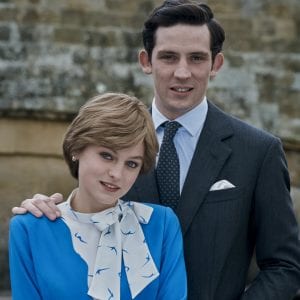
Diana and Charles are played by Emma Corrin and Josh O’Connor
Who could argue with him? After all, a shades-of-gray drama is messier and much less enthralling than bold black and white.
But with some helpful end credits about important people and events, “The Crown” presents itself as the unquestioned biographical source, which can be dangerous for viewers who don’t know the truth and the many real-life characters who are very much still alive.
“The objections range from the personal (the queen’s brittle, coldhearted treatment of her emotionally fragile daughter-in-law, which the critics claim is unfair) to the political (the show’s portrait of Thatcher-era Britain as a right-wing dystopia, in the grip of a zealous leader who dares to lecture her sovereign during their weekly audiences),” according to a recent New York Times piece. “Historians say that is utterly inconceivable.”
“There has been such a reaction because Peter Morgan is now writing about events many of us lived through and some of us were at the center of,” said Andrew Neil, who edited London’s The Sunday Times from 1983 to 1994. The events involving his paper in “The Crown” did happen, such as the row over the apartheid regime in South Africa.
But Neil disputed several elements of “The Crown” retelling, not least that Buckingham Palace made the queen’s press secretary, Michael Shea, the scapegoat for the incident. The show depicts his being fired for having leaked the story, even though it suggests that he did so at the queen’s behest. There is no evidence of this, Neil said.
“He gets to depict Thatcher as pretty much an ally of apartheid while the queen is the sort of person who junks loyal flunkies when things go

The real 1981 engagement photo of the royal couple
wrong, even when they are just doing her bidding,” he said.
Simon Jenkins, a columnist for the left-leaning Guardian, regards members of the royal family as artifacts of celebrity culture irrelevant to a country grappling with real-world challenges like Brexit, he told the New York Times. “They are practically defunct,” he said. “They are like anthropomorphized figures of a head of state.”
Royal historian Hugo Vickers argues that this season is “yet more subtly divisive than earlier seasons,” and pretty much every character emerges as unlikable with the exception of Diana.
Vickers, who has written about Queen Elizabeth and the Queen Mother, has enjoyed discrediting The Crown’s storylines so much that he’s penned an entire book (and e-book devoted to the current season) fact-checking the series, according to a recent Vanity Fair story. He said Charles (now 72, and married to Camilla since 2005) is treated especially unfairly.
“They always liked to portray him as a kind of wimp. This time, though, he’s not only portrayed as a wimp, but also as a very angry, unpleasant person yelling at his wife,” Vickers told Vanity Fair. “Some of the looks he gives Diana, you begin to wonder whether in the next season we’re going to catch him conspiring to have her murdered in a tunnel in Paris, or something ghastly,” he said. “I wouldn’t put it past them [on The Crown]…it’s really, really disgraceful what they’ve done to him in this season.”
“I mean, does he ever do any work? Does he ever do an engagement? Does he ever actually achieve anything? No, they didn’t show a single thing that he does,” Vickers said. In reality, the prince is “very dedicated, and he’s done everything that he’s been asked to do all his life,” he said. “He’s parachuted in the sea [as colonel-in-chief of the Parachute Regiment], gone into the Navy…He’s gone on government departments. He’s traveled around the Commonwealth. He set up the Prince’s Trust.”
The trickiness with the series, in the opinion of Vickers and other royal biographers like Sally Bedell Smith, is this: “Because The Crown is such a lavish and expensive production, so beautifully acted and cleverly written, and so much attention has been paid to visual details about historical events, viewers are tricked into believing that what they are seeing actually happened,” Bedell Smith told Vanity Fair. “While the earlier seasons were period pieces, this is recent history, so it seems more cruel in its false depictions.”
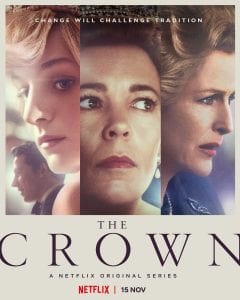
The new season of “The Crown” stars Olivia Colman (center) as Queen Elizabeth II and Gillian Anderson (right) as Margaret Thatcher.
Another real-life incident that gets fictionalized treatment in the series is the two 1982 palace break-ins by Michael Fagan, an unemployed father embittered by Thatcherism. The show personalizes the rampant unemployment under Thatcher, as he can’t find work, and can’t get the help he needs to make his apartment a safe place for his kids.
When Fagan loses custody of his children, he feels let down by the leaders of his country, particularly Thatcher, whom he can’t understand why she’s devoting so much time and treasure to the Falklands War, and ignoring people like him.
The painter-decorator broke into Buckingham Palace in July 1982 and found his way to the Queen’s bedroom, though they apparently didn’t have the riveting, deeply moving talk as portrayed by Morgan in “The Crown.” The writer never approached Fagan about the incident, he told The Telegraph ahead of the fourth season’s debut.
While the show depicts Fagan having a conversation with the Queen on that fateful night of the break in, in reality the exchange was brief. “I pulled back the curtain and she said, ‘What are you doing here?’” Fagan said in the interview. After a moment of Fagan sitting on the bed, he reported that she added, “I’ll be back in a minute,” and quickly left the room.
Fagan was then taken down the hall and given a whiskey by a footman, and was arrested shortly thereafter.
In the show, Fagan speaks with the Queen about Margaret Thatcher, detailing his problems with her leadership. But in actuality, Fagan, who has given a number of different accounts of his encounter with the British monarch over the years, said that was not the case, according to The Telegraph. “A lot of people thought like that,” he said, admitting that he had not been a supporter of Thatcher at the time. “She did a lot of damage to children.”
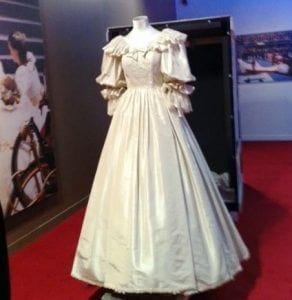
The original wedding dress worn by Princess Diana July 29, 1981, seen that day by 750 million people on TV.
Nonetheless, he said, he had no explanation for why he broke into the palace. Some accounts say he was high on mushrooms at the time.
Early in “The Crown” season four, there’s a haunting episode where Diana accompanies Prince Phillip on a hunt, when in the same episode, she’s literally hunted by photographers who seemed to stalk her everywhere – up to her fateful death at 36 in a 1997 car crash.
In the season finale, Prince Philip (Tobias Menzies) visits Diana in her room at Sandringham and urges her not to break away from the marriage, suggesting that it would lead to negative consequences for her.
“If this family can’t give me the love and security that I feel I deserve, then I feel I have no option but to break away officially, and to find it myself,” Diana tells Philip.
“I wouldn’t do that if I were you,” Philip responds.
When Diana asks him why not, he says: “Let’s just say I don’t see it ending well for you.” (Ouch!) “I hope that isn’t a threat, Sir,” Diana says.
Hugo Vickers believes this scene is meant to allude to the conspiracy theory that the royal family were somehow involved in Diana’s death.
“I imagine we’re going to get an episode where he is seen conspiring to have her killed in the tunnel,” Vickers told Insider.
The princess was killed when the vehicle she was traveling in crashed after being chased by paparazzi in a Paris tunnel at the end of August 1997, one year after her divorce from Charles.
Memories of Diana at the Putnam
“The Crown” is especially meaningful for Davenport’s Michele Darland, who has worked at the Putnam Museum and was on an exhibit committee with her mother, setting up teas and group visits during the 2013 blockbuster, “Diana: A Celebration,” featuring the famous wedding dress.

Emma Corrin as Diana and Josh O’Connor as Charles on “The Crown.”
“Can it be true Netflix has ‘The Crown’ and a documentary on Diana at the same time? I was in heaven,” Darland said in a recent e-mail. “I watched them back-to-back. What struck me was that in the show and in the documentary was that Charles barely hid his lack of love for her.
“She didn’t want to see it, she had such hopes and dreams of this marriage — that was brokered on everything but love,” she said. “I can tell you exactly where I was when I heard of the accident. I stayed up to watch the funeral at 5 a.m. our time. I remember having coffee with Kim Findlay in Theo’s and she said to me, do you think we should bring the Diana exhibit to the Putnam and I said move heaven and earth to bring this exhibit here, Kim. She did.”
“As a single mother with two boys, I could relate to Diana, Princess of Wales and I think everyone fell in love with her on some level,” Darland wrote. “Well, not Charles. While watching the documentary, they showed her trip to Angola to rid the land mines and seeing her in the denim shirt with khakis made me burst into tears. I so distinctly remember pressing my face to the glass looking at the very outfit she wore while viewing the breathtaking exhibit.
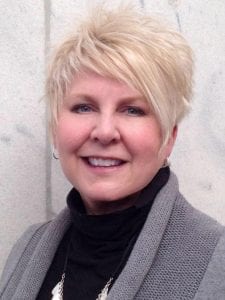
Kim Findlay was Putnam president/CEO during the Diana exhibit.
“When I left the exhibit, I wept. Such loss,” she said. “I felt very much for the boys and what would mine go through if they lost me. Seeing the boys walk behind her casket with the notecard with the word ‘Mummy’ on it makes me weep all over again. She had her troubles and she had her triumphs which I think every woman can understand. She truly was the people’s princess.”
Kim Findlay, who was president/CEO of the Putnam at the time, hasn’t seen “The Crown,” but recalled this week of the Diana exhibit –
“The Princess Diana exhibit enticed people from 48 states and several foreign countries to visit the Putnam. Thanks to wonderful support from sponsors and fortunate timing, the Putnam was the second-to-last venue to ever host the stunning and emotional exhibit. I recall visitors going through dozens of boxes of tissues as they exited the exhibit having just viewed a video in remembrance of Diana.”
“Of all the stunning designer gowns — and they truly were beautiful — Diana’s iconic wedding gown . . . The beyond-description diamond tiara . . . More than any of those pieces, my favorite was the slacks, top, face shield and protective vest she wore when she walked over part of a minefield in Angola in 1997,” Findlay said.
“She was aware that her actions generated global attention and with courage, determination and compassion, she made sure the world took notice of an issue that impacted the people left to live in war-torn countries. I believe it was acts like these that made people love her more and more.”
Due to the surge in attendance during the 2013 holiday season for “Diana: A Celebration,” which chronicled the life and death of the former Princess of Wales, the Putnam extended its stay three weeks, until Jan. 26, 2014.
Since the Diana exhibit opened Sept. 14, 2013, it attracted more than 30,000 visitors, including 4,000 alone from Dec. 26 to 29, Findlay said in January 2014.
On loan from Althorp Estate, the Spencer family’s 500-year-old ancestral home in England, the exhibition contained 150 objects, ranging from Diana’s wedding gown and tiara and 28 of her designer dresses, to family heirlooms, personal mementos, paintings and rare home movies and photos. It was an amazing, profoundly emotional experience to see.
“There’s obviously a lot of interest and demand out there. It is a world-class exhibit right here in our own community,” Findlay said in 2014,

Michele Darland is a huge Diana fan who volunteered during the exhibit.
noting it attracted many visitors from outside the area.
One of the out-of-town visitors was Maria Shebetka, of Cedar Rapids, who won the replica of Princess Diana’s engagement ring, valued at $7,000 and made by James Revell of Bettendorf’s Revell Jewelers. Chosen out of 750 people who bought a new Putnam membership or renewed a membership, Shebetka came to see the exhibit with a group of women from her church.
She had never been to the Putnam before and bought a membership because she believes in institutions like the museum, and said this would keep her coming back.
Diana’s original engagement ring — now worn by Prince William’s wife, Kate Middleton — has 14 diamonds surrounding a 12-carat oval blue sapphire, but the replica has a smaller 5.39-carat center stone circled by diamonds.
“Diana: A Celebration” was last shown at the Cincinnati Museum Center. It had toured the world since 2003, and the items returned to her sons in England to be preserved for future generations.
The subject of Diana touched a nerve the same way the tragic 1912 sinking of the Titanic does, Findlay said of the emotion surrounding this

“Diana: A Celebration” was at the Putnam from September 2013 to January 2014.
exhibit, which concluded with the outpouring of grief following Diana’s 1997 death.
“People have told me about getting up at 4 in the morning to watch the (1981) wedding,” she said. “”This was a woman who was really famous, who also was a humanitarian, a mom, and all the excellent work that she did while she was in the spotlight.”
An eloquent eulogy by her brother Charles, the 9th Earl Spencer, at her funeral, said in part —
“For such was her extraordinary appeal that the tens of millions of people taking part in this service all over the world via television and radio who never actually met her, feel that they too lost someone close to them in the early hours of Sunday morning. It is a more remarkable tribute to Diana than I can ever hope to offer her today.
“Diana was the very essence of compassion, of duty, of style, of beauty,” her brother said. “All over the world she was a symbol of selfless humanity. All over the world, a standard bearer for the rights of the truly downtrodden, a very British girl who transcended nationality. Someone with a natural nobility who was classless and who proved in the last year that she needed no royal title to continue to generate her particular brand of magic.”
Since 2014, Diana’s wedding dress has been in the private collection of Prince William and Prince Harry, as she had requested at the time they both turned 30. Previously, the dress had been displayed at Althorp House, where Diana is buried.
Virtual exhibit on “The Crown” and “Queen’s Gambit”
In conjunction with the Netflix original limited series “The Queen’s Gambit” and the fourth season of The Crown, the Brooklyn Museum is presenting a virtual exhibition of digitally rendered and interactive 360-degree views of costumes from the two series, along with related objects from our collection, all set within a rendering of the Museum’s soaring Beaux-Arts Court.
Available online through Dec. 13, and designed by Gabriele Binder, costumes for The Queen’s Gambit reflect the growing sophistication and self-assurance of the main character, fictional 1960s chess champion Elizabeth “Beth” Harmon, often incorporating structural lines and black-and-white patterns, materializing elements of the game into her wardrobe.
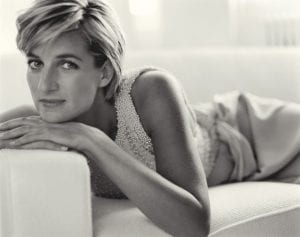
Lady Diana as photographed by Mario Testino.
Emmy-winning costume designer Amy Roberts constructed detailed outfits inspired by looks worn by the formidable 20th-century British women in The Crown, including Queen Elizabeth II, Princess Margaret, Princess Diana, and Prime Minister Margaret Thatcher.
Works from the Museum collection were selected by Matthew Yokobosky, Senior Curator, Fashion and Material Culture. Highlights include an example of the ancient Egyptian board game senet (circa 1938–1799 B.C.E.), American photographer Arthur Tress’s Boys on Checker Floor, Far Rockaway, NY (1973), and Guyanese British artist Hew Locke’s Koh-i-noor (2005), a portrait of Queen Elizabeth II made from hundreds of plastic toys and trinkets, among others.
The virtual exhibition draws on the Brooklyn Museum’s history of organizing and presenting exhibitions connecting fashion design and Museum objects, including Killer Heels: The Art of the High-Heeled Shoe (2014), David Bowie is (2018), and Pierre Cardin: Future Fashion (2019).
The exhibition includes a virtual panel discussion with Binder, Roberts, and Yokobosky, who go behind the scenes to explore insights into the wardrobe creations for the two shows. The panel is moderated by Academy Award–winning costume designer Ruth E. Carter.
With elaborate embroidery, 10,000 pearls, and a 25-foot-long train, Diana’s custom wedding dress has undoubtedly become the most iconic in modern history.
Two other can’t-miss Diana films
Netflix has naturally capitalized on the renewed Diana fervor, by highlighting two complementary film projects released over the past 14 years – both also incomparably sad.
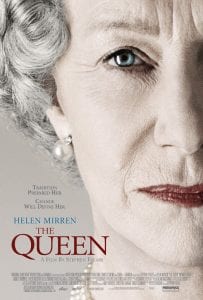
“The Queen” (2006) earned Helen Mirren an Oscar for her portrayal of Queen Elizabeth II.
Peter Morgan’s “The Queen” (2006) was directed by Stephen Frears, and is as much about Diana’s impact as Queen Elizabeth II, portrayed with icy reserve and strict, towering authority by Helen Mirren.
Unlike “The Crown” (this season ends in 1990), it does not attempt to fictionalize Diana, as it uses real news clips before and after her death on Aug. 31, 1997. Initially, the British royal family regard Diana’s death as a private affair and thus not to be treated as an official royal death.
This sharply contrasts with the views of the new, young Prime Minister Tony Blair and Diana’s ex-husband, Prince Charles, who support the general public’s desire for an official expression of grief. Matters are further complicated by the media, royal protocol regarding Diana’s official status, and wider issues about republicanism, according to a film synopsis.
Mirren appears far less attractive and personable as both Claire Foy and Olivia Colman in “The Queen,” as she extends more compassion for a stag that was shot than the dead mother of her grieving grandsons. Even when the starchy, dignified monarch is convinced by her 10th prime minister to deliver a televised speech about Diana, she might as well as been speaking from another planet – as far out of touch and dryly inhuman she seems.
For her understated, monumental performance, Mirren earned numerous awards, namely the Academy Award for Best Actress, BAFTA Award for Best Actress in a Leading Role, and Golden Globe for Best Actress in a Motion Picture – Drama. Mirren was praised by the Queen herself and was invited to dinner at Buckingham Palace. However, Mirren couldn’t attend due to filming commitments in Hollywood.
In the 2017 television documentary, “Diana: In Her Own Words,” recordings of Diana recount her tumultuous marriage to Charles, including his alleged apathy toward her and his ongoing relationship with Camilla from even before they tied the knot.
“It is another great irony that decades after her death, Diana’s story remains a point of almost compulsive fascination for the public, and her innermost struggles and private agonies are the subjects of three new high-profile media events,” according to a recent piece at popdust.com.
As with “The Crown” and “Diana: In Her Own Words,” another People’s Princess pic is set, as Kristen Stewart is due to play Diana in a new movie called “Spencer,” which will detail her split from Prince Charles. “Save any major missteps, the combination of Stewart’s and Diana Spencer’s star power is sure to create legions of new Diana devotees,” popdust.com wrote.
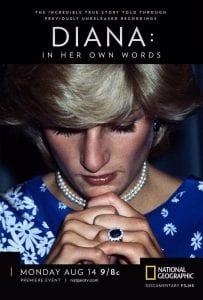
The documentary “Diana: In Her Own Words” was released in 2017.
The 2017 National Geographic documentary is set to interviews with Diana in the early ‘90s, primarily for Andrew Morton and his biography, “Diana: Her True Story.” In 1993, it was made into a television film of the same name, with Serena Scott Thomas as Princess Diana. Following Diana’s death in August 1997, Morton issued an edition entitled Diana: Her True Story in Her Own Words in October 1997.
Diana felt overwhelmed by the relentless commitments of royal life. Stalked and abused by paparazzi, she suffered from chronic bulimia that began the week after her engagement to Charles as well as morning sickness, depression, and feelings of perpetual alienation.
The titanic tragedy of Diana (who would have turned 60 next July 1) seems like an intersection of two terrible fates – being ignored and unappreciated by her husband, and over-attended and stalked by an impossibly intrusive press and paparazzi. As Alanis might say, isn’t it ironic?
Like all of us, she just wanted to be loved, to connect, to find meaningful, important ways to express herself, to help others and find herself.
“She voluntarily completed the series of secret interviews that would comprise Andrew Morton’s bestselling book and later this documentary,” says the popdust.com piece. “She exposed her suicide attempts and marital dissatisfaction to the public with complete awareness that this information would make headlines across the world.
“After she broke from the Royal Family, told her story, and abandoned the illusion of perfection, she did appear to be healing, leaning into her humanitarian work and taking new lovers. She played a crucial role in fighting stigma about HIV/AIDS and traveled around the world bringing joy and empathy to the masses.”
No one is perfect, but unlike many elected leaders, Diana at least made an effort – and tried to use her talents in a selfless way, to make a difference in the world. Her example shines still and should inspire us all.


